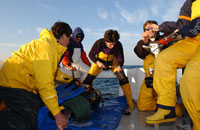On the heels of
the ICCAT meeting in Tenerife, I joined Dr. Pablo
Cermeño (TAG/Stanford University, WWF, KAI
Marine Services), and a team from the Moroccan National Institute of Fisheries Research (INRH)
(Noureddine Abid), ICCAT’s Atlantic-wide Research Programme for Bluefin
Tuna (GBYP) (Dr. M’Hamed Idrissi), the World Wildlife Fund’s (WWF) Mediterranean Programme (Dr.
Gemma Quilez-Badia, Naima Rodríguez López), and the tuna trap
"Es-Sahel" (Larache, Morocco), owned by "Société
Maromadraba".
 |
| The Morocco 2013 tuna tagging team. From left to right: Dr. Pablo Cermeño, Dr. Gemma Quilez-Badia, Naima Rodríguez López, Dr. M'Hamed Idrissi, Dr. George Shillinger, and Noureddine Abid. |
 |
| Geographical location of the El Sahel trap and other Moroccan traps along the Atlantic coast (Abid et al., ICCAT SCRS/2011/081). |
 |
| Artisanal fishing boats in the harbor at Larache. Image: George Shillinger |
 |
| Fishing boats in the harbor at Larache, Morocco. Image: George Shillinger |
 |
| View of Larache, Morocco from the harbor. Image: George Shillinger |
Dr.
Cermeño initiated this exciting collaboration for TAG during 2012, after
working with ICCAT and WWF during 2011 to tag tuna caught within the Moroccan tuna
traps. Société Maromadraba had reached its quota in two days and was prepared
for us to commence tagging fish remaining in the Es-Sahel trap, as per the research
agreement established with ICCAT and partners. The trap was now filled with
over 4000 giant tuna, estimated to average over 2.25 meters and weigh over 220
kgs apiece.
 |
| Boats, floats, nets, and anchors comprise the Es-Sahel tuna trap off Larache, Morocco. Image: George Shillinger |
 |
| Artesinal fishermen working at the Es-Sahel tuna trap off Larache, Morocco. Image: George Shillinger |
The
goal of the tagging expedition was to deploy acoustic tags, mini-PATs tags, and
conventional tags on this enigmatic aggregation of Atlantic bluefin tuna. Fish tagged during the 2012 deployment by the ICCAT-GBYP
and WWF at the Es-Sahel trap travelled to putative Mediterranean spawning grounds in the South Balearic
Islands and off the coast of Libya, and to Atlantic habitats off the Azores and Madeira.
 |
| Tracks of nine Atlantic bluefin tagged off Larache, Morocco during 20012 by ICCAT-GBYP and WWF (Quilez-Badia et al., ICCAT SCRS/2012/143). |
This
year’s addition of acoustic tags to the tracking effort will potentially allow
us to obtain longer-term data about movements and residency patterns within
Mediterranean and Atlantic foraging habitats that are equipped with receiver
arrays. It is anticipated that a line of
acoustic receivers deployed by the Ocean Tracking Network (OTN) will eventually
span the Strait of Gibraltar (“Gibraltar Curtain”), between Spain and Morocco,
enabling us to record the passage and seasonal movements of the tagged fish
between the Atlantic and Mediterranean.
Bluefin tuna are linked to all the ancient civilization inhabiting the Mediterranean. Aristotle (384 BC – 322 BC) in his “History of Animals” described not only the species but also migration along the Mediterranean. Bluefin tuna have been a source of food for millennia; Phoenicians started fishing tuna in the Mediterranean c. 3000 year ago with a net that evolved into modern day tuna traps. Similarly Romans, Greeks and Middle age Dukes exploited this resource, and the fishing continues today.
Tuna traps use a passive net system anchored near shore to capture migratory bluefin tuna. A wall net coming from land to off-shore tries to direct the tuna to a labyrinth of nets during its spawning migration to the Mediterranean and in some areas when leaving the Med after spawning. Once the tuna reach the final chamber the fishermen bring up the tuna capturing them with the help of hand-hooks.
 |
| Schematics of ancient Mediterranean tuna traps (source unknown). |
 |
| Image depicting fishermen at a Mediterranean tuna trap (origin and site unknown -- possibly Zahara, Spain). Source:http://www.zaharaenlaweb.com/es/paginas/almadrabas-de-zahara-de-los-atunes |
 |
| La pêche du thon (La pesca del tonno), acquaforte di Jean-Pierre Houël, 1782. Source: Voyage pittoresque des Isles de Sicile, de Malte et de Lipari. Paris, 1782. |
The Atlantic Moroccan tuna trap
fishery contributes on average up to 70% of Morocco’s total bluefin catch (~
1450 metric tons), and comprises approximately 5% of the total bluefin catch
within the Eastern Atlantic and Mediterranean (Abid et al., SCRS/2011/081). The first Moroccan traps were established
nearly a century ago. Today the traps occur along the north Atlantic coast of Morocco to the Strait of Gibraltar. They are typically
situated around 3 nautical miles offshore, extending to depths of around 60 m. Since the trap fishery is primarily directed
at the spawning fraction of the Eastern Atlantic bluefin stock, it provides a
unique opportunity for generating abundance indices to monitor stock status and
inform stock assessments. Relatively easy access to
the trapped fish also provides researchers with a unique opportunity to deploy electronic tags on fish that would be otherwise inaccessible or extremely
challenging to encounter through conventional (e.g. recreational sportfishing)
tag deployment methodologies.
 |
| Proportion of East Atlantic and Mediterranean tuna traps catches by area and by flag. (Abid et al., ICCAT SCRS/2011/081) |






















